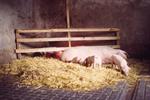 All domesticated pigs are descended from two closely related species: sus vittatus, from Asia (mainly China and Thailand) and Sus scrofa, the wild pig of Europe and North Africa.
All domesticated pigs are descended from two closely related species: sus vittatus, from Asia (mainly China and Thailand) and Sus scrofa, the wild pig of Europe and North Africa.
The Asian pig has short legs, a wide dished face and the ability to fatten rapidly. The influence of this pig can be seen in the Berkshire and Middle White breeds. The European pig was thin with a long, pointed face. The Tamworth is a modern pig that shows these characteristics. Fixing and improvement of breeds has been taking place for over one hundred years. Pigs are kept only for the production of meat. The meat can be used in two different ways - pork and bacon. As such, two distinct types of pig have evolved. The pork type for the production of fresh meat and the bacon type for the production of cured meat, bacon and ham.
In modern pig husbandry, it is not so important to choose a pork type or a bacon type. Due to better breeding, stricter selection and, above all, scientific feeding the modern pig can produce good quality pork or bacon. The feeding system and age at slaughter will determine what the pig will produce.
Where to House Pigs
Pigs in a group quickly establish a pecking order or social status which will remain in place as long as they are together. The most dominant pigs will become the senior pigs in the group. These are the pigs that tend to eat the most so become larger and heavier than the other pigs. There will always be some variation in the weights of pigs being fattened for this reason.
Pigs should be housed in small groups of seven to nine for fattening. Larger groups spend more time fighting and show larger variations in weights as well as taking longer to reach market weight. Whenever practical, hogs (males) should be penned separately from gilts. Hogs will eat, on average, half a kilogram more than gilts and will steal the gilts food if they are fed together. Hogs run to fat quicker too so it is a good idea not to allow them access to more food than their ration allows.
The accepted minimum floor area per pig is between 1.0 to 1.3 m, but it has been proven that a larger floor area promotes greater daily gain. There should be a sleeping area and a dunging area with adequate feed trough space for the number of pigs in each pen. There must also be enough water trough space or drinking nipples for the pigs.
In warmer places (e.g. Mediterranean areas); pigs can be fattened in relatively simple buildings because of the kinder climate. It is far more profitable to attend to management than to build pigs palaces! A box - type sleeping area that can be covered in winter and uncovered in summer is the main requirement. The dunging passage does not need to be covered. The whole of the sleeping and feeding area can be roofed with thatch or asbestos sheets and it is a good idea to insulate the latter. Ventilation is all important to keep the house cool in summer, warm in winter and free of noxious gases at all times. This particularly applies to pigs housed inside.
Is This the Course For You?
You can enrol on the Pig Husbandry course at any time.
The course is self-paced, so you can study at a time and location to suit you.
Whether you are looking to improve your pig management skills, raise pigs as a commercial venture, or even as a hobby this course offers a solid source of learning.
Graduates of the course may use what they learn in a range of possible situations:
-
As a Piggery manger
-
Free range pig farmer
-
Piggery hand
-
Pig breeder
-
Research Institute roles
-
Manufacturing/supplying products to the pig industry
-
Marketing or sales
-
Wholesale/Retail Specialist
-
Teaching or writing about pigs
-
As a Self sufficiency consultant
- Caring for "pet" pigs
-
A foundation for further studies
Any Questions?
Our Pig Husbandry tutors are happy to answer any questions about the course, so please do ask.
Or